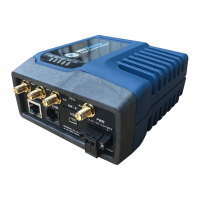206 MDS Orbit MCR/ECR Technical Manual MDS 05-6632A01, Rev. F
type bridge
admin-status up
oper-status up
if-index 1
phys-address 00:06:3d:07:96:82
statistics discontinuity-time 2014-02-12T14:29:35-05:00
statistics in-octets 263244716
statistics in-unicast-pkts 3231995
statistics in-multicast-pkts 0
statistics in-discards 4126
statistics in-errors 0
statistics out-octets 785224
statistics out-unicast-pkts 1362
statistics out-discards 0
statistics out-errors 0
ipv4 forwarding true
ipv4 mtu 1500
PREFIX
IP LENGTH ORIGIN
------------------------------------------------------------
10.10.10.141 23 static
LINK LAYER
IP ADDRESS ORIGIN STATE
--------------------------------------------------------------------------------
10.10.10.98 80:c1:6e:f0:3b:7a dynamic delay
bridge stp port ETH1
number 1
priority 0
state forwarding
path-cost 100
designated-root 7035.04fe7fe36980
designated-cost 100
designated-bridge 8000.0002fd5dd280
designated-port 32783
Routing 3.8.6
Understanding
The Orbit MCR can forward IP packets between routed interfaces, using a network path defined by the
user. These user-defined network paths are known as static routes. A static route may be configured if
data intended for a specific subnet or IP address must egress a particular onboard NIC.
As an example, consider a case where the unit is connected to a local network, 10.10.0.0/24, through its
ETH2 port. This network contains a gateway at IP address 10.10.10.101. This gateway is also connected
to another network 216.171.112.0/24, which has a NTP server. The Orbit MCR must use this network
path to access an NTP server at IP address 216.171.112.36. A static route to network 216.171.112.0/24
via next-hop 10.10.10.101 (or a host-only route to 216.171.112.36/24 via next-hop 10.10.10.101) ensures
that the unit can communicate with the NTP servers.

